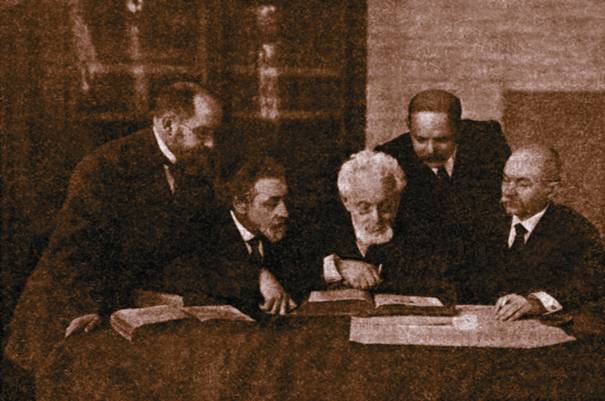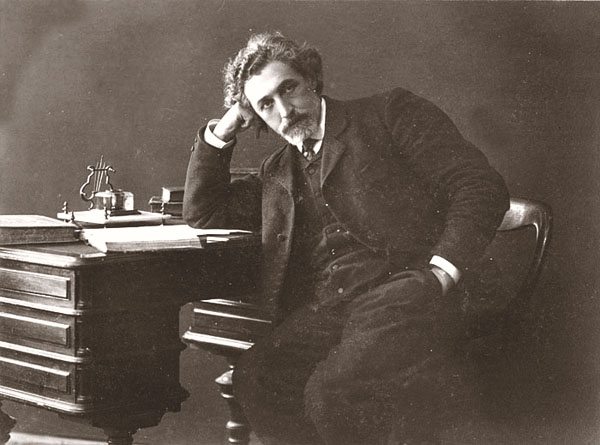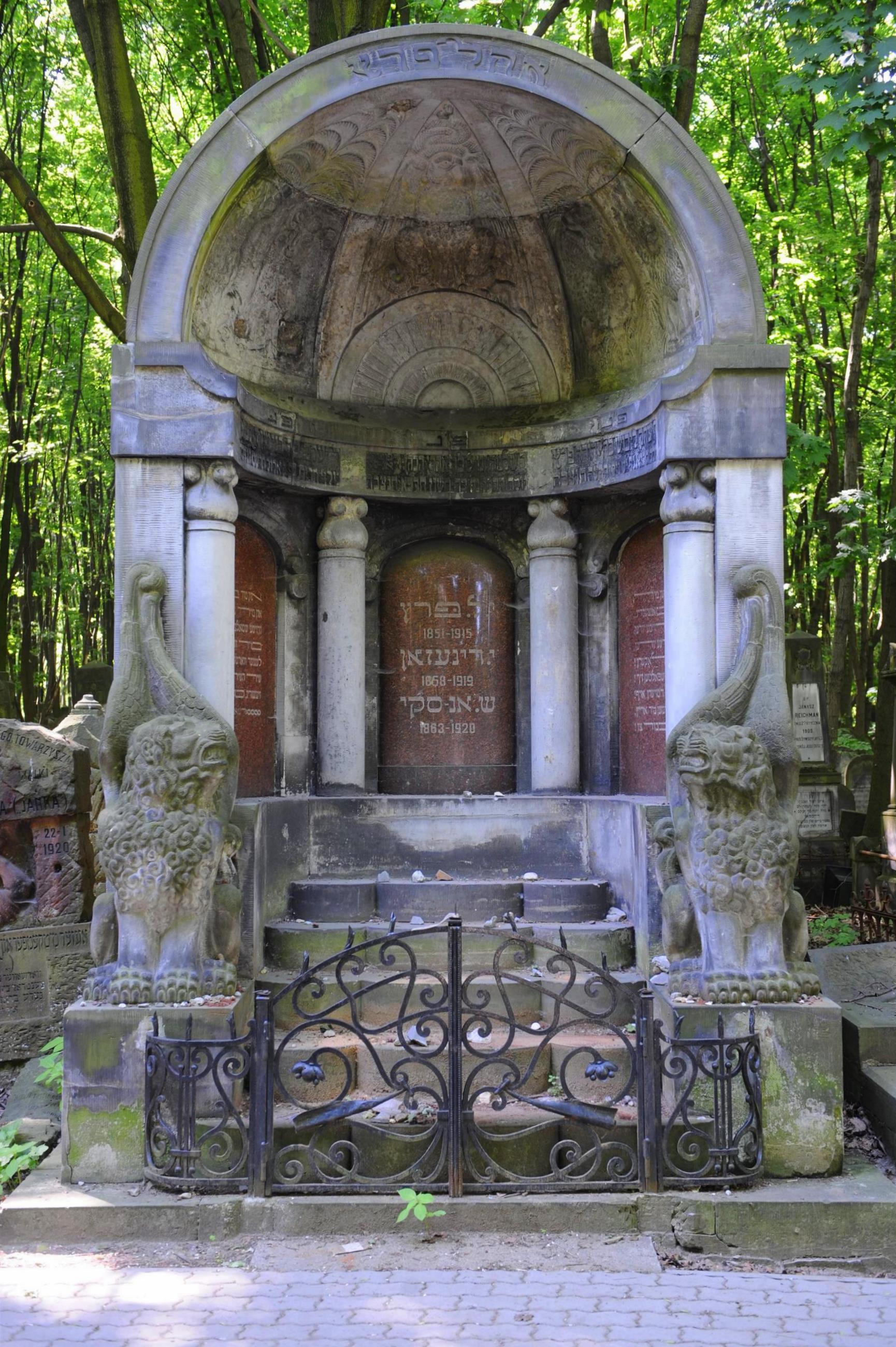S. Ansky on:
[Wikipedia]
[Google]
[Amazon]
Shloyme Zanvl Rappoport (1863 – November 8, 1920), also known by his
 Shloyme Zanvl Rappoport was born in Chashniki, Vitebsk Governorate,
Shloyme Zanvl Rappoport was born in Chashniki, Vitebsk Governorate,
 Under the influence of the Russian narodniki movement, An-sky became interested in
Under the influence of the Russian narodniki movement, An-sky became interested in
 Initially he wrote in Russian, but from 1904 he became known mainly as a
Initially he wrote in Russian, but from 1904 he became known mainly as a
Jewish Heritage Online article on Ansky
archived from th
on 2016-01-01
YIVO Encyclopedia of Jews in Eastern Europe
{{DEFAULTSORT:An-sky, S. 1863 births 1920 deaths People from Chashniki People from Lepelsky Uyezd 19th-century Jews from the Russian Empire Belarusian Jews Narodniks Bundists Socialist Revolutionary Party politicians Russian Constituent Assembly members Yiddish theatre Yiddish-language dramatists and playwrights Dramatists and playwrights from the Russian Empire Folklorists from the Russian Empire Jewish folklorists 20th-century pseudonymous writers Jewish writers from the Russian Empire
pen name
A pen name or nom-de-plume is a pseudonym (or, in some cases, a variant form of a real name) adopted by an author and printed on the title page or by-line of their works in place of their real name.
A pen name may be used to make the author's na ...
S. An-sky, was a Jewish
Jews (, , ), or the Jewish people, are an ethnoreligious group and nation, originating from the Israelites of History of ancient Israel and Judah, ancient Israel and Judah. They also traditionally adhere to Judaism. Jewish ethnicity, rel ...
author, playwright, researcher of Jewish folklore, polemicist, and cultural and political activist. He is best known for his play '' The Dybbuk'' or ''Between Two Worlds'', written in 1914, and for Di Shvue, the anthem of the Jewish socialist Bund. In 1912-1914, he led the Jewish Ethnographic Expedition to the Pale of Settlement
The Pale of Settlement was a western region of the Russian Empire with varying borders that existed from 1791 to 1917 (''de facto'' until 1915) in which permanent settlement by Jews was allowed and beyond which the creation of new Jewish settlem ...
.
In 1917, after the Russian Revolution
The Russian Revolution was a period of Political revolution (Trotskyism), political and social revolution, social change in Russian Empire, Russia, starting in 1917. This period saw Russia Dissolution of the Russian Empire, abolish its mona ...
, he was elected to the Russian Constituent Assembly
The All Russian Constituent Assembly () was a constituent assembly convened in Russia after the February Revolution of 1917. It met for 13 hours, from 4 p.m. to 5 a.m., , whereupon it was dissolved by the Bolshevik-led All-Russian Central Ex ...
as a Social-Revolutionary deputy.
Biography
 Shloyme Zanvl Rappoport was born in Chashniki, Vitebsk Governorate,
Shloyme Zanvl Rappoport was born in Chashniki, Vitebsk Governorate, Russian Empire
The Russian Empire was an empire that spanned most of northern Eurasia from its establishment in November 1721 until the proclamation of the Russian Republic in September 1917. At its height in the late 19th century, it covered about , roughl ...
(now Belarus
Belarus, officially the Republic of Belarus, is a landlocked country in Eastern Europe. It is bordered by Russia to the east and northeast, Ukraine to the south, Poland to the west, and Lithuania and Latvia to the northwest. Belarus spans an a ...
), but spent his childhood in Vitebsk. He was from a poor religious family, and he had only a heder education. His mother ran a tavern. He left his home and moved to Liozno in his late-teens, and worked as a tutor; he was ostracised by his community for "disseminating radical ideas". He wrote his first novel, "History of a Family", in Yiddish, it was translated and published in Russian in 1884.
Rappoport was actively involved in revolutionary movements, initially as a populist (known as narodniki) and later as a member of the Socialist Revolutionary (SR) Party. At this time, he changed his name from Jewish to Russian, Semyon Akimovich. In 1880s, in the spirit of Going to the People movement, popular among populists, he moved to Ekaterinoslav region, where he worked as a tutor and in the "salt- and coal-mining industry". He believed in the importance of the education of Russia's peasants and participated in activities such as collecting workers' songs and giving public readings, which led to his arrest in 1888. In 1892, he was introduced to the literary circles of St. Petersburg, where he started writing under the pen name S. An-sky. He moved to Paris in 1892 and lived in Europe until 1905. He mainly wrote in Russian, but eventually started to write in Yiddish too. He also worked as a secretary for Russian philosopher Petr Lavrov in Paris. He had a short marriage to a "French-Russian woman". After Lavrov's death, An-sky moved to Switzerland, where, together with Viktor Chernov, he founded a populist Agrarian Socialist League. In 1904-1905, he was an editor of the Yiddish socialist journal ''Kampf un kempfer'' (The Fight and the Fighters).
An-sky returned to Russia in 1905, after the revolution. He debated prominent figures like Simon Dubnow
Simon Dubnow (alternatively spelled Dubnov; ; rus, Семён Ма́ркович Ду́бнов, Semyon Markovich Dubnov, sʲɪˈmʲɵn ˈmarkəvʲɪdʑ ˈdubnəf; 10 September 1860 – 8 December 1941) was a Jewish-Russian Empire, Russian h ...
, Chaim Zhitlowsky
Chaim Zhitlowsky (Yiddish: חײם זשיטלאָװסקי; ) (April 19, 1865 – May 6, 1943) was a Jewish Socialism, socialist, philosopher, social and political thinker, writer and literary critic born in Ushachy Raion, Ushachy, Vitebsk Governora ...
, and Shmuel Niger on various issues, including Jewish revolutionary dedication, Christian imagery in Jewish literature, and the trilingual vision of modern Jewish literature. An-sky also became active in Jewish publishing, editing and contributing to several Jewish journals and encyclopedias. From 1908 to 1918, he traveled extensively, lecturing on Jewish cultural topics while remaining involved in Socialist Revolutionary politics. He published works on anarchism and revolutionary plays, and was arrested in 1907 "for disseminating revolutionary propaganda". He had another failed marriage in 1908, to Esther Glezerman.
In 1912-1914, An-sky with a small team went for an ethnographic expedition to the Pale of Settlement, collecting thousands of photographs, folk tales, songs, and artefacts. Based on the collected materials, An-sky wrote his most famous work, the play '' The Dybbuk''. It was soon translated to Yiddish, and is now regarded as one of the most famous plays of the Yiddish theatre.
During the World War I and until the October Revolution of 1917, An-sky worked for Jewish Committee for the Relief of War Victims; in 1920 he published his memoir of this times, ''Khurbn Galitsye'' (The Destruction of Galicia). After the revolution, he escaped to Vilna and then to Warsaw, where he died of a heart attack on November 8, 1920.
Ethnographic work
 Under the influence of the Russian narodniki movement, An-sky became interested in
Under the influence of the Russian narodniki movement, An-sky became interested in ethnography
Ethnography is a branch of anthropology and the systematic study of individual cultures. It explores cultural phenomena from the point of view of the subject of the study. Ethnography is also a type of social research that involves examining ...
, as well as socialism, and became a political activist. Between 1912 and 1913, An-sky headed the Jewish Ethnographic Expedition, financed by Baron Vladimir Günzburg and named in honor of his father Horace Günzburg, which traveled through Podolia and Volhynia
Volhynia or Volynia ( ; see #Names and etymology, below) is a historic region in Central and Eastern Europe, between southeastern Poland, southwestern Belarus, and northwestern Ukraine. The borders of the region are not clearly defined, but in ...
in the Pale of Settlement
The Pale of Settlement was a western region of the Russian Empire with varying borders that existed from 1791 to 1917 (''de facto'' until 1915) in which permanent settlement by Jews was allowed and beyond which the creation of new Jewish settlem ...
. They documented the oral traditions and customs of the native Jews, whose culture was slowly disintegrating under the pressure of modernity. According to his assistant Samuel Schreier-Shrira, An-sky was particularly impressed by the stories he heard in Miropol of a local sage, the hasidic rebbe Samuel of Kaminka-Miropol (1778 – May 10, 1843), who was reputed to have been a master exorcist of '' dybbuk'' spirits. Samuel served as the prototype for the character Azriel, who is also said to reside in that town. Historian Nathaniel Deutsch suggested he also drew inspiration for ''The Dybbuk'' from the Maiden of Ludmir, who was also rumored to have been possessed, thus explaining her perceived inappropriate manly behavior. He composed a detailed ethnographic questionnaire of 2,087 questions.
An-sky's ethnographic collections were locked away in Soviet vaults for years, but some material has come to light since the 1990s. The State Ethnographic Museum at St. Petersburg holds a good deal of it.Tracing An-sky: Jewish Collections from the State Ethnographic Museum in St. Petersburg, Amsterdam 1992 Some of his vast collection of cylinder recordings made on these expeditions were digitized by the Vernadsky National Library of Ukraine, which holds the collection.Materials of J. Engel Ethnographic Expedition 1912 (The Historic Collection of Jewish Music 1912-1947, vol. 1) (Kiev: National Academy of Sciences of Ukraine; Vernadsky National Library of Ukraine; Institute for Information Recording, 2001) Deutsch compares the An-sky's expedition materials to genizah, particularly to the Cairo genizah.
His ethnographic report of the deliberate destruction of Jewish communities by the Russian army in the First World War, ''Khurbn Galitsiye'' (The Destruction of Galicia), has become a major source in the historiography of the war's impact on civilian populations.
Literary career
Yiddish
Yiddish, historically Judeo-German, is a West Germanic language historically spoken by Ashkenazi Jews. It originated in 9th-century Central Europe, and provided the nascent Ashkenazi community with a vernacular based on High German fused with ...
author.
He is best known for his play '' The Dybbuk'' or ''Between Two Worlds'', written in 1914. The play was first staged in the Elyseum Theatre in Warsaw
Warsaw, officially the Capital City of Warsaw, is the capital and List of cities and towns in Poland, largest city of Poland. The metropolis stands on the Vistula, River Vistula in east-central Poland. Its population is officially estimated at ...
, on December 9, 1920, one month (at the end of the 30-day mourning period) after the author's death. It was subsequently translated into a dozen or more languages and performed thousands of times all over the world. It is still being produced, along with numerous adaptations, as well as operas, ballets, and symphonic suites. (For example, in 2011 there were seven different productions.) It is considered the jewel of the Jewish theatre. In the early years ''The Dybbuk'' was considered so significant that parodies of it were written and produced.
Although ''The Dybbuk'' is An-sky’s best-known work, he published many works of literature, politics and ethnography. His ''Collected Works'', which do not include all his writings, comprise fifteen volumes. An-sky wrote a number of other plays, four of which are included in this collection, long out of print. One (''Day and Night'') is, like ''The Dybbuk'', a Hasidic Gothic story. The other three plays have revolutionary themes, and were originally written in Russian: ''Father and Son'', ''In a Conspiratorial Apartment'', and ''The Grandfather''. All four have recently been republished in a bilingual Yiddish-English edition.''S. An-sky. Four Plays. Bilingual Edition,'' tr. Fernando Peñalosa. Tsiterboym Books, 2013.
An-sky was also the author of the song '' Di Shvue'' (The Oath), which became the anthem of the Jewish Socialist Bund party. He was the author of the poem (later made into a song) " In Zaltsikn Yam" (In the Salty Sea), which was also dedicated to the Bund.
Selected publications
* Sketches on Folk Literacy, 1892/1894 * Hungry, 1892 * Mendel the Turk, 1892 * Pioneers, 1904–1905 * On a New Course, 1907 * Jewish Folk Art, 1908 * The Folk and the Book, 1913 * '' The Dybbuk'', 1914 * The Destruction of Galicia, 1920 * Album of the Jewish Artistic Heritage (published posthumously)Notes
References
Sources
* * * * * * Mlotek, Eleanor G. '' S. Ansky : (Shloyme-Zanvl Rappoport) 1863-1920 : His Life and Works : Catalog of an Exhibition.'' ew York YIVO Institute for Jewish Research, 1980. OCLC 10304171 * * * *External links
Jewish Heritage Online article on Ansky
archived from th
on 2016-01-01
YIVO Encyclopedia of Jews in Eastern Europe
{{DEFAULTSORT:An-sky, S. 1863 births 1920 deaths People from Chashniki People from Lepelsky Uyezd 19th-century Jews from the Russian Empire Belarusian Jews Narodniks Bundists Socialist Revolutionary Party politicians Russian Constituent Assembly members Yiddish theatre Yiddish-language dramatists and playwrights Dramatists and playwrights from the Russian Empire Folklorists from the Russian Empire Jewish folklorists 20th-century pseudonymous writers Jewish writers from the Russian Empire